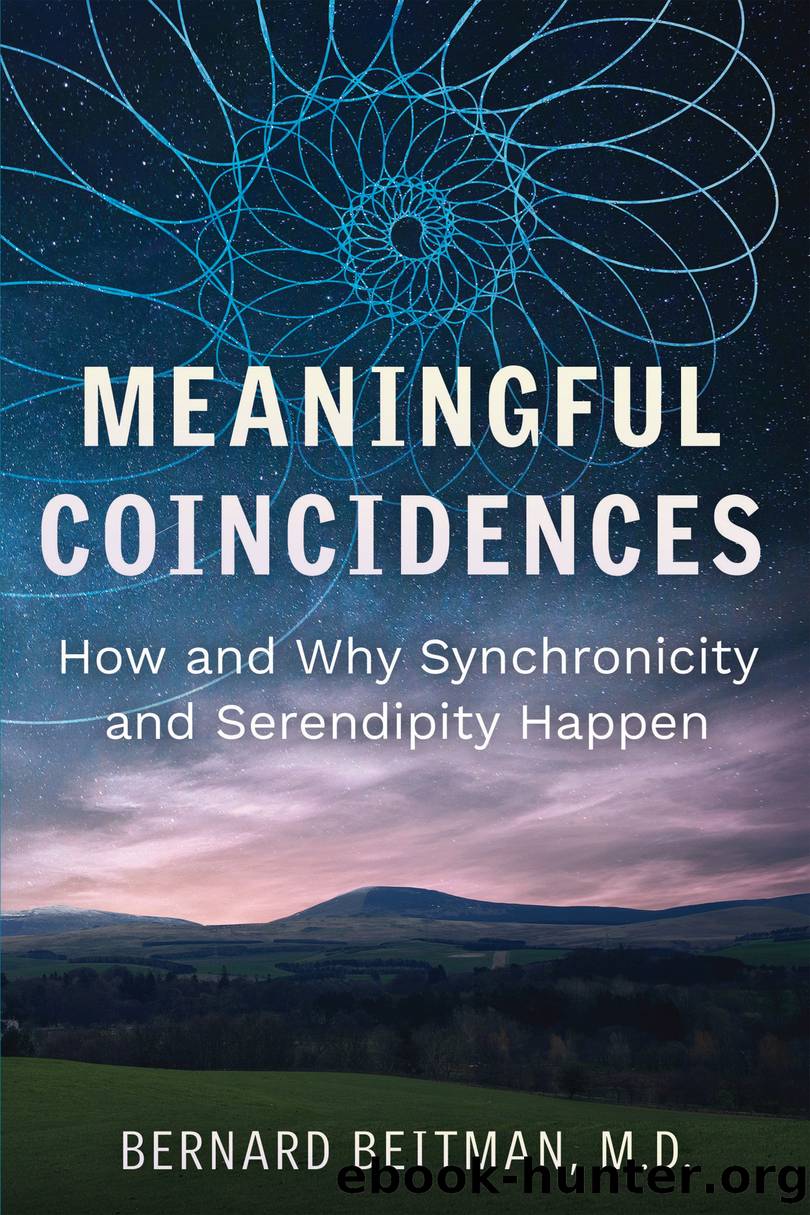Meaningful Coincidences by Bernard Beitman

Author:Bernard Beitman
Language: eng
Format: epub
Tags: Spirituality/Self-Help/Memoir
Publisher: Inner Traditions/Bear & Company
Published: 2022-06-11T00:00:00+00:00
PART 3
Incorporating Coincidence into Your Life
11
âThere Are No Coincidencesâ
The statementââThere are no coincidencesââreveals a paradox at the core of the subject of coincidences. Embedded in the definition of a coincidenceâas two or more events coming together in a surprising, unexpected way without an obvious causal explanationâis a suggestion that there might be an explanation. But the possibility of an explanation creates the opportunity for saying âthere are no coincidences.â Because if a cause can be defined, then itâs not a coincidence. Or âitâs too much of a coincidence to be a coincidence.â
If, as some people believe, God is the cause behind a coincidence, itâs no longer a coincidence. When God is called in to explain coincidences, you are the recipient of divine grace. If you think you had something to do with it, you are deluding yourself. âCoincidences are Godâs way of remaining anonymous,â they say. Or, âIt was meant to be.â
Experiences involving human GPS and other forms of psychic ability appear to be coincidences. But because psi is not recognized by mainstream science, psi events, which clearly do happen, are regarded as just a coincidence. But once conventional science recognizes psi as real, these events will no longer be regarded as coincidences. Except, that is, for the vexing problem of explaining psi events. Labeling them as psi events is a start.
So what remains after all possible explanations for a coincidence are exhausted? Randomness. But in this case, even the word coincidence would no longer apply, as they would just be random events, not coincidences.
Since coincidence research is, in part, an attempt to understand the underlying causes of coincidences, once they are understood, they are no longer coincidences!
Even as God, statistics, psychic abilities, and other means of personal agency are considered as explanation for coincidences, some remain unexplainedâwithout a cause. It is in this residue of cases that some researchers seek an understanding of the nature of reality. Serial coincidences, for example, many of which appear to have no personal meaning, suggest to some that there is an underlying pattern to reality that is being hinted at.
Paul Kammerer, the Viennese biologist mentioned earlier, attempted to systematize his observations of these series and to develop explanations for how they occur within the limits of current scientific knowledge. He proposed that information could not be destroyed. The longer a system stays together, every part within and surrounding it gains the stamp of the system. When the system does break apart, the broken pieces carry with them the marks of the original system. One way to create coincidences comes from their constant motion; the parts can run into each other. Using the idea that like attracts like, similar parts of the same system come together to create a coincidence series. Kammerer believed that our environment holds limitless amounts of information that is in constant motion and mostly outside of our ability to perceive it.1
Jung discounted this theory but was able to use Kammererâs suggestion of a yet-to-be defined cause as support for his acausal synchronicity principle.
Download
This site does not store any files on its server. We only index and link to content provided by other sites. Please contact the content providers to delete copyright contents if any and email us, we'll remove relevant links or contents immediately.
The remains of the day by Kazuo Ishiguro(8379)
Tools of Titans by Timothy Ferriss(7806)
Giovanni's Room by James Baldwin(6803)
The Black Swan by Nassim Nicholas Taleb(6761)
Inner Engineering: A Yogi's Guide to Joy by Sadhguru(6439)
The Way of Zen by Alan W. Watts(6288)
Asking the Right Questions: A Guide to Critical Thinking by M. Neil Browne & Stuart M. Keeley(5355)
The Power of Now: A Guide to Spiritual Enlightenment by Eckhart Tolle(5329)
The Six Wives Of Henry VIII (WOMEN IN HISTORY) by Fraser Antonia(5234)
Astrophysics for People in a Hurry by Neil DeGrasse Tyson(4998)
12 Rules for Life by Jordan B. Peterson(4160)
Housekeeping by Marilynne Robinson(4059)
The Ethical Slut by Janet W. Hardy(4036)
Skin in the Game by Nassim Nicholas Taleb(3965)
Double Down (Diary of a Wimpy Kid Book 11) by Jeff Kinney(3922)
Ikigai by Héctor García & Francesc Miralles(3889)
The Art of Happiness by The Dalai Lama(3844)
Skin in the Game: Hidden Asymmetries in Daily Life by Nassim Nicholas Taleb(3720)
Walking by Henry David Thoreau(3681)
